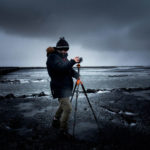Harsh, contrasty lighting works for edgy and highly-stylized portraits, but the majority of the general studio photographer’s portrait gigs call for soft, flattering, and evenly-distributed light. Soft studio lighting can be created in many different ways, but portrait photographer Daniel Norton prefers using large silks coupled with reflector panels.
In the following video, Norton demonstrates his methodology and walks viewers through seven simple steps to creating effective one light studio setups and soft, beautiful portrait light:
Setting the Stage
For his tutorial, Norton uses a 39″ x 6′ Westcott Scrim Jim Medium Frame with a Scrim Jim Medium Full Stop Silk and Studio Depot Duvetyne Light Block-Out Cloth. He illuminates the silk with a Profoto B1 AirTTL Flash and 50° Profoto Magnum Reflector and he reflects that light onto his subject via a 42″ x 42″ Scrim Jim Small Frame outfitted with Scrim Jim Small Silver White Fabric.
To record his images, Norton employs a Profoto Air Remote Transceiver, Fujifilm X-PRO1 Mirrorless Camera, Voigtlander Heliar 75mm f/1.8L, and Metabones Leica M Lens to Fuji X Adapter.
How to Create Soft Light
- Set up a large silk and a studio strobe.
- Attach black duvetyne cloth to the bottom of the scrim to prevent stray light from bouncing back up into the subject’s face and causing unseemly shadows.
- Set up a large black panel on the opposite side of the scrim to keep light from reflecting onto the subject’s shadow side. This is especially important if you’re using a studio that contains natural light and reflective surfaces.
- Position the strobe so that it’s shining through the silk perpendicular to the subject. Making some of the light spill past the front of the scrim and silk will provide ample light to harness with a reflector panel later on.
- Line the subject up with the back of the scrim so that the light is in front of them and wraps softly around their face and body softly. The closer to the camera the subject moves, the more shadows you will see on the subject’s face.
- Take a test photo without a reflector to see whether you like the evenness of light across the subject’s face or want to add a reflector to lessen shadows.
- Position the reflector to harness the light from the strobe that you allowed to spill past the front of the silk. Adjust your exposure and the position of the reflector according to your preferences. Moving the reflector closer to the subject will reduce the light intensity.

A portrait created using a silk only
“There’s definitely some shadow on one side because the light’s coming from one direction,” said Norton, “but [the exposure] is virtually even across her face.”

A portrait created using both a silk and reflector
“I want it to be a tiny bit overexposed. I want that kind of punch that you get with the silver reflector to add a kind of fashion feel to it.”
In the final scenes of his instructional video, Norton demonstrates that this method is equally as effective for individual portraits as it is for group photos, with a few modifications. To illuminate both of his subjects evenly, Norton drops his scrim down onto its side and switches out the black card panel from the previous setup with a white card panel.
“A silk is a really versatile tool. Depending on how you position it and how you position your light through it, you can get so many different looks with it.”
Like This Article?
Don't Miss The Next One!
Join over 100,000 photographers of all experience levels who receive our free photography tips and articles to stay current:






Leave a Reply